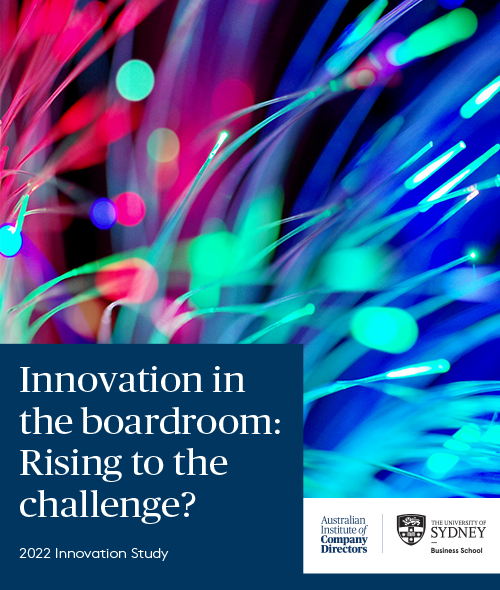A new study by the AICD and The University of Sydney Business School has found that boards are responding to the need for a stronger focus on innovation to succeed in a rapidly evolving business landscape.
The upheaval caused by the COVID-19 pandemic, combined with intensified competitive pressures, has prompted directors in Australia to adopt more innovative practices, according to the AICD and The University of Sydney Business School’s 2022 Innovation Study.
As a result, the majority of businesses are working towards improved business processes, structures, products and even new business models. This most recent study Innovation in the boardroom: Rising to the challenge is a follow-up to a 2019 study, Driving innovation: The boardroom gap, which was the first of its kind in Australia and one of just a few reports globally to examine the role of the board in driving organisational innovation.
Only a handful of survey respondents said innovation is not a priority or is a matter for management alone. The increased focus on innovation has been expressed among all organisations, across the full range of maturity levels and sectors, including listed and not-for-profit organisations.
These findings are cause for “cautious optimism”, notes AICD managing director and CEO Mark Rigotti MAICD.
“In 2019, we found that Australian boardrooms recognised the importance of innovation, but struggled to prioritise it,” he says in the foreword to the study. “In 2022, we have found that the long journey towards prioritising innovation and making it part of the way we do business, has begun.”
However, Rigotti adds that directors now need to maintain the momentum without the driver of necessity behind them. A key recommendation is for all boards to ensure that innovation is part of “how we do business” in both the boardroom and the organisation. Vision and leadership from the most senior leaders in the organisation has been identified as one of the most critical aspects for a culture that nurtures innovation.
1. Innovation as a competitive advantage
The CSIRO has identified global “megatrends” that require innovation — both to capitalise on opportunities and ride out stormy waters. Some of these megatrends include adapting to climate change, geopolitical shifts and an increasing reliance on autonomous technology.
These factors combined require more from boards, which must move from being largely reactive to pre-emptive, says Andrew Stevens MAICD, chair of Industry, Innovation and Science Australia. He believes that the currently accepted period of “dwell time” is “not good enough in today’s world”. He wants to see more boards adopt a “predict and act” approach, which is more effective in driving growth and innovation.
The world’s best-performing organisations have been found by researchers to compete on the basis of innovation. Rather than trying to slow down competitors, they’re constantly striving to anticipate the future needs of their customers.
Sally-Ann Williams GAICD, CEO of Cicada Innovations, believes that the digitisation of certain processes and the shift from legacy systems was long overdue and should be seen as distinct from genuine innovation.
“Every board has played digital catch-up on something that they should have been doing for the past 10 or 15 years,” she says. “Now they’ve accelerated that, and that’s great. But I don’t think that’s innovation. That’s the bare minimum for efficient and future-proofing operations of your organisation.”
2. Be clear on risk appetites
Dr Eileen Doyle FAICD, non-executive director of Santos, encourages boards to be clear about their organisational risk appetite. A strong understanding will enable boards to take measured risks.
“When you do your risk planning, you need to be able to be clear about your risk appetite” she says. “You might have a really low risk appetite for safety, but you might have a higher risk appetite for new technology in particular aspects of your business. Or you might have a medium risk appetite in your dealings with government. This allows anyone in the organisation to understand the areas where they can take risk and where failure is acceptable.”
3. An innovation mindset is crucial
The report makes a series of recommendations for bolstering innovation — chief among them developing an innovation mindset through cognitive diversity. This is critical to meeting demands brought about by substantial uncertainty and disruption in the markets.
“The innovation mindset is developed through experience in facing challenges, fast-growing organisations and enterprise-wide transformations,” states the report.
It is critical for boardrooms to be comprised of some directors with firsthand experience in innovative organisations, as they will be accustomed to questioning and pushing management.
“Directors must be able to bring an ‘innovation mindset’ to board deliberations, while boards need to start hiring more directors with real world innovation experience,” states the report. “In a typical board of around nine members, the chair should consider whether they have enough directors with an innovation mindset to shape the conversation.”
Study findings
- Innovation has clearly been prioritised as part of the boardroom conversation, while risk appetite has not substantially increased.
- The involvement of directors in strategy and innovation adds value in achieving outcomes.
- Mature boards don’t use the word innovation - it is just an integrated part of doing business.
- The greatest drivers for a culture that enables innovation are vision and leadership, as they promote innovative behaviours, an openness to new ideas and experimentation.
- The board needs a critical mass of directors who bring an innovation mindset and experience in innovative organisations.
- Board education is crucial to developing and maintaining a shared focus on innovation.
Recommendations
- Constructively challenge the management team and continue questioning long-standing assumptions on whether innovation is possible and its timeframe for implementation.
- Boards must ensure that innovation is part of “how we do business” in both the boardroom and the organisation.
- Directors must be able to bring an “innovation mindset” to board deliberations, while boards need to start hiring more directors with real-world innovation experience.
- A greater focus on emerging trends and potential impacts to business models is needed to predict future scenarios and be prepared to act.
- Gaining an outside perspective via experts, advisory boards and technology committees is critical to staying on top in an uncertain and complex environment.
Latest news
Already a member?
Login to view this content



